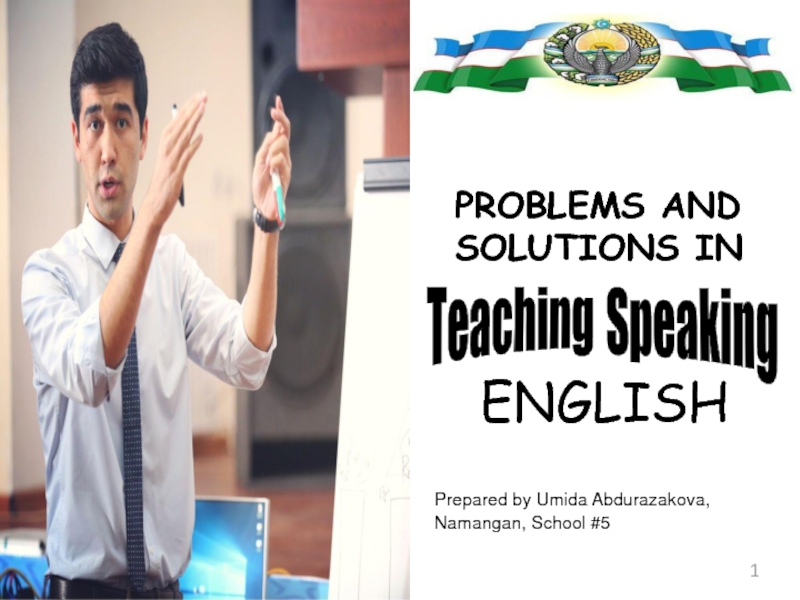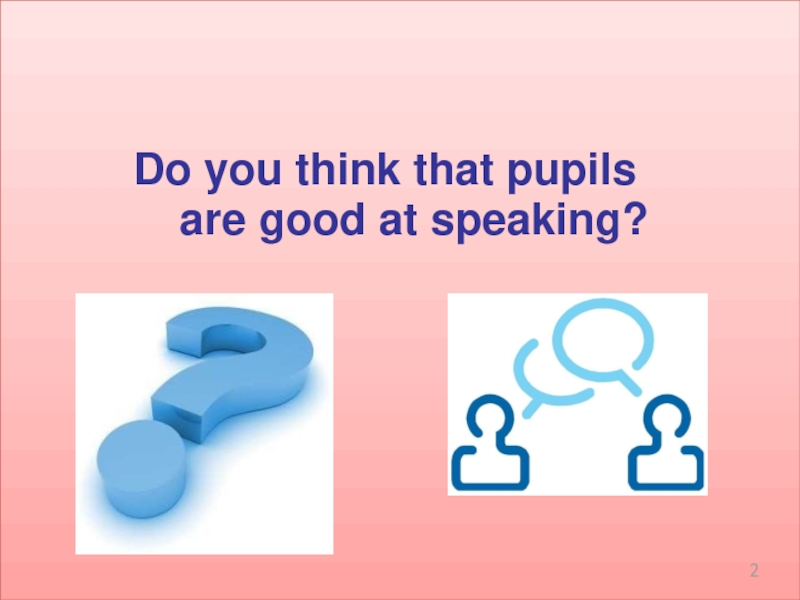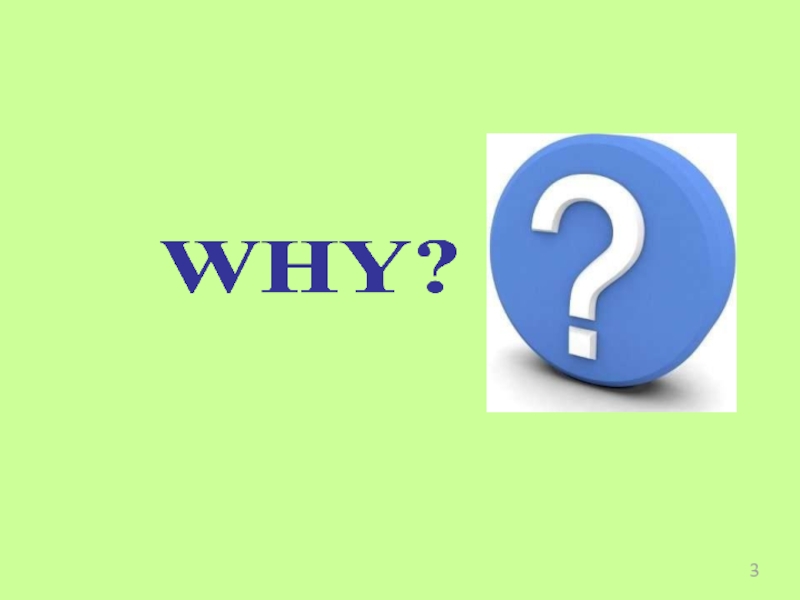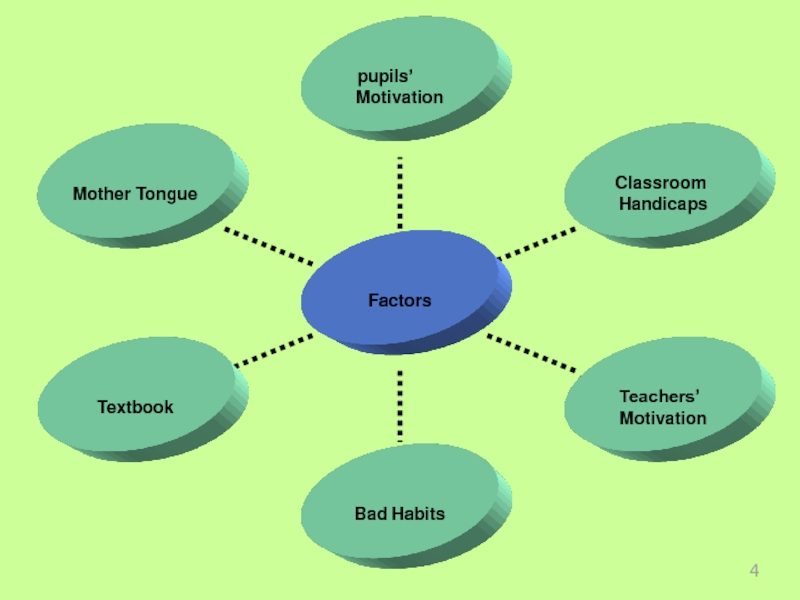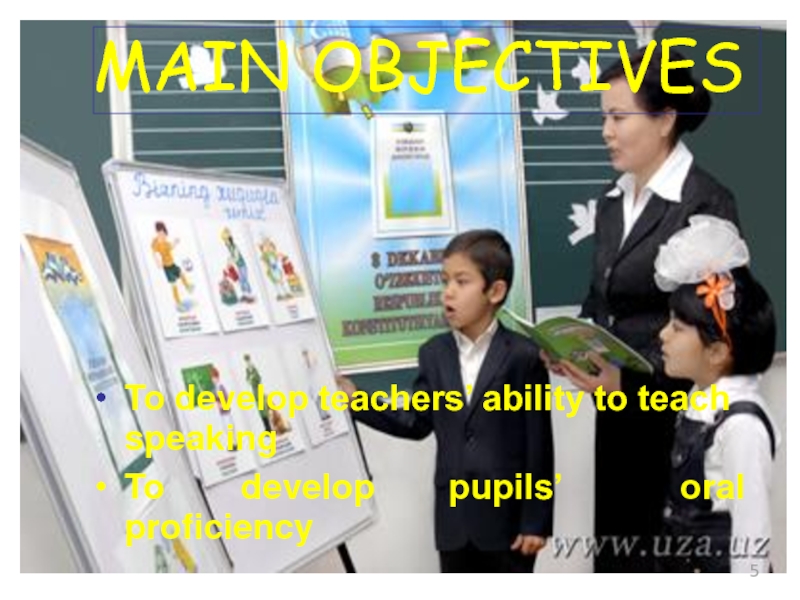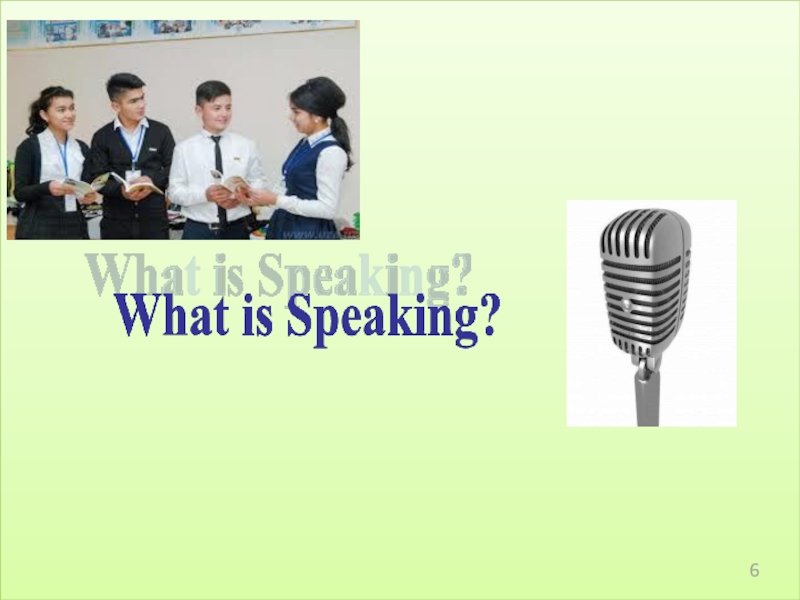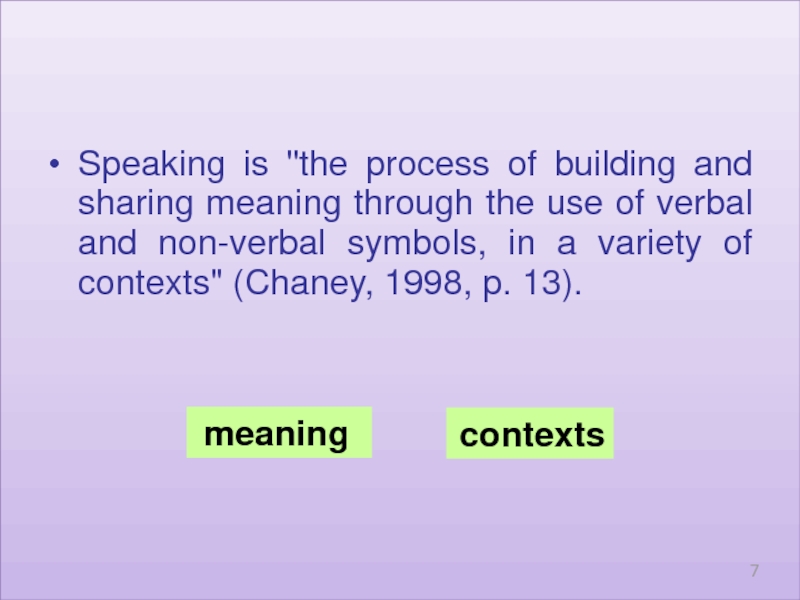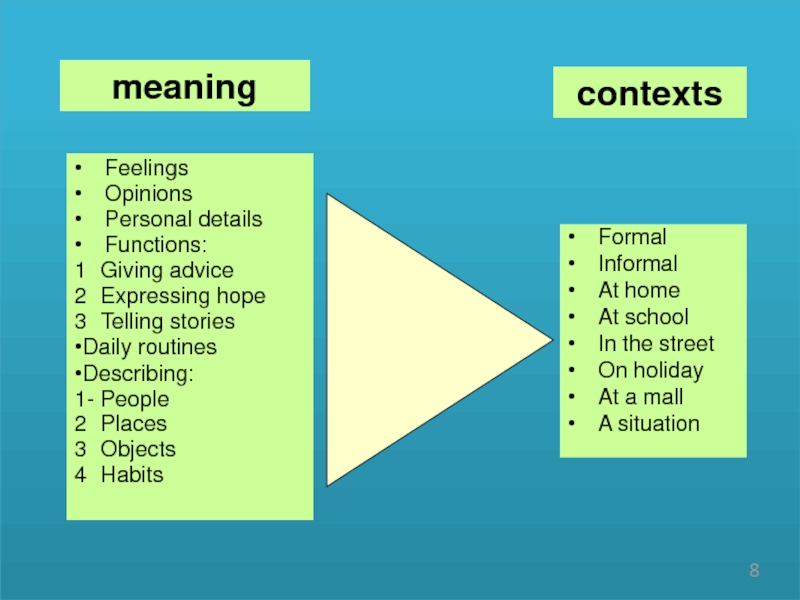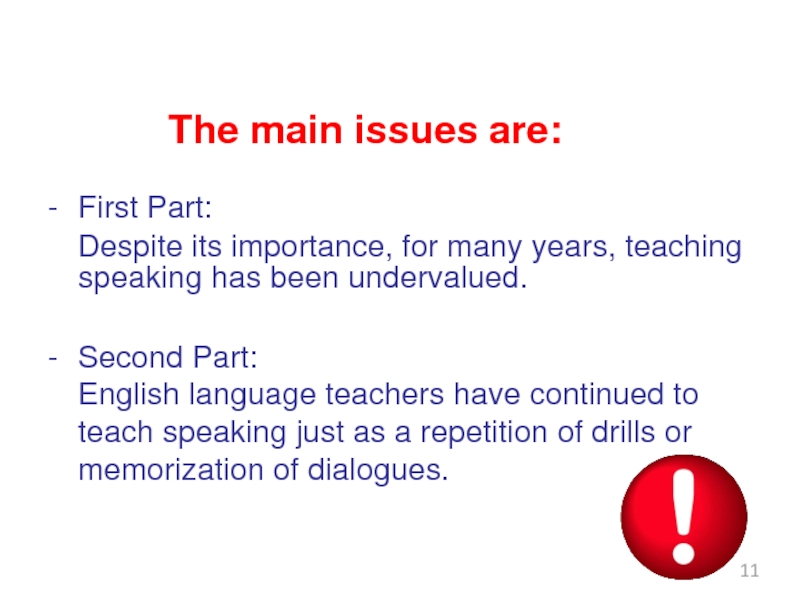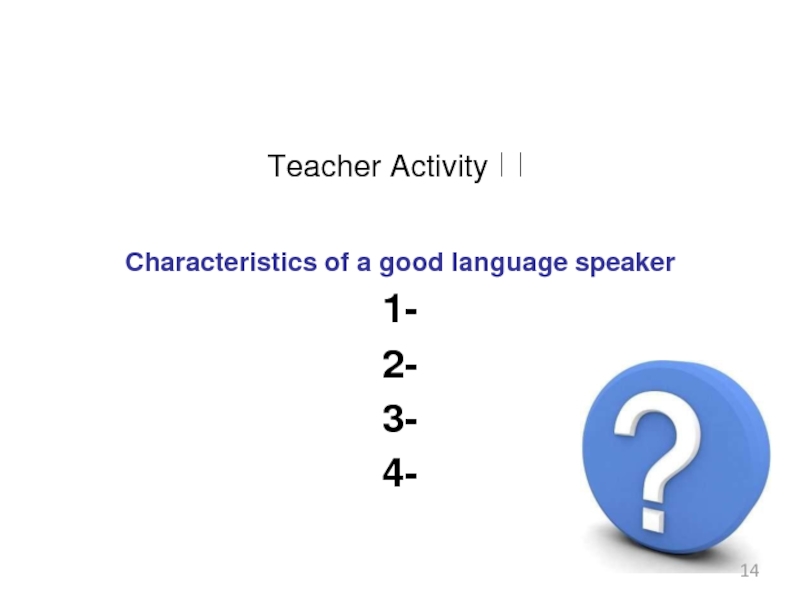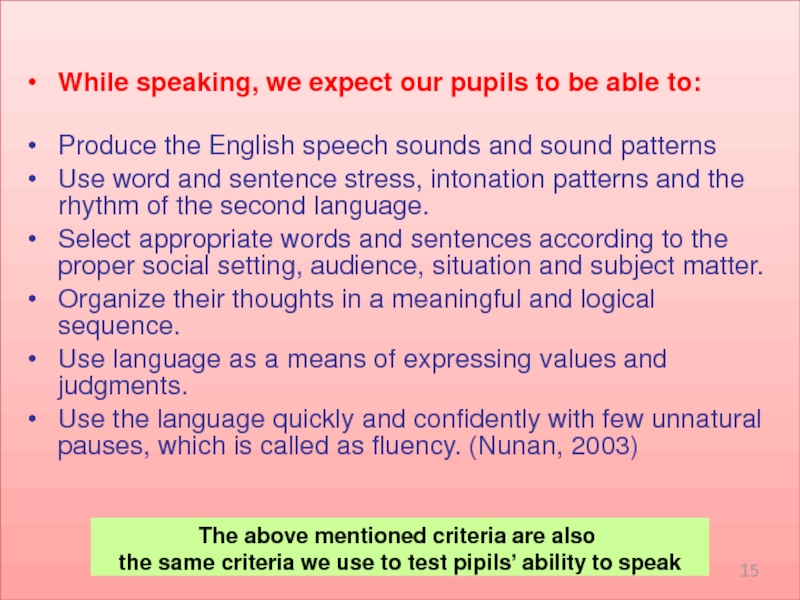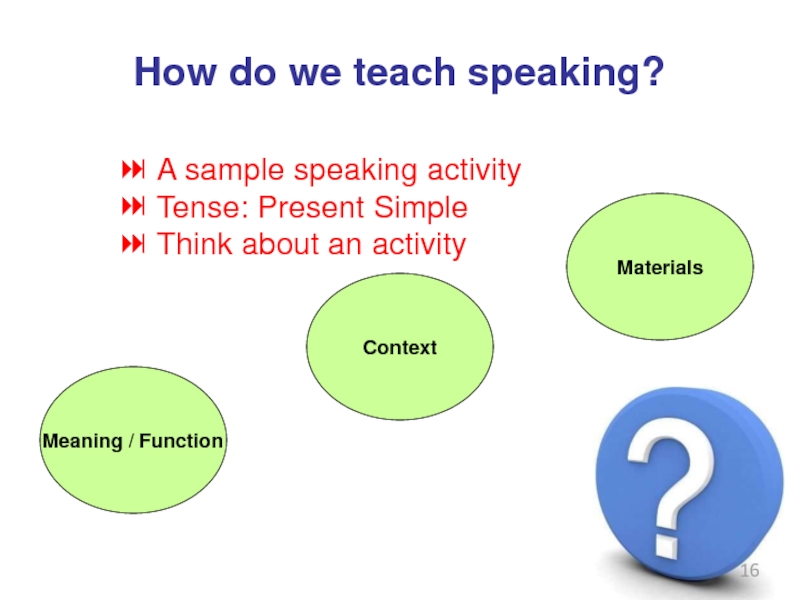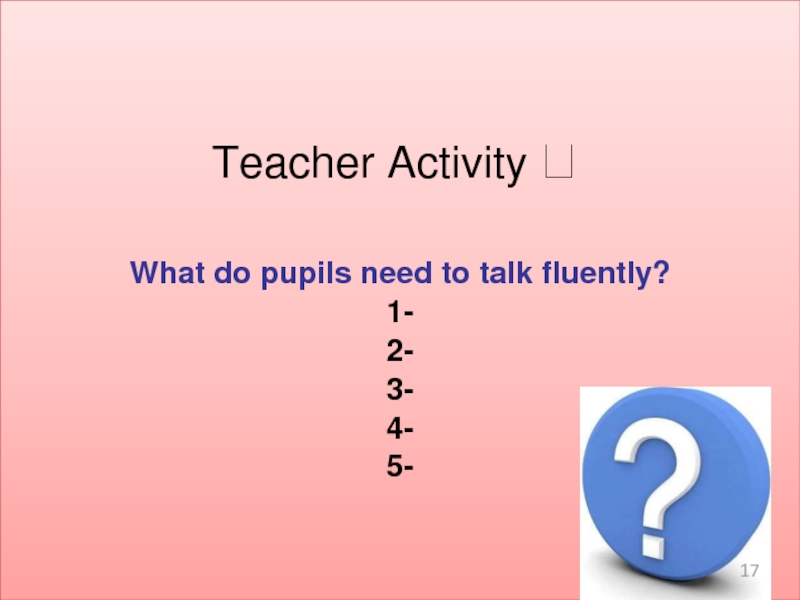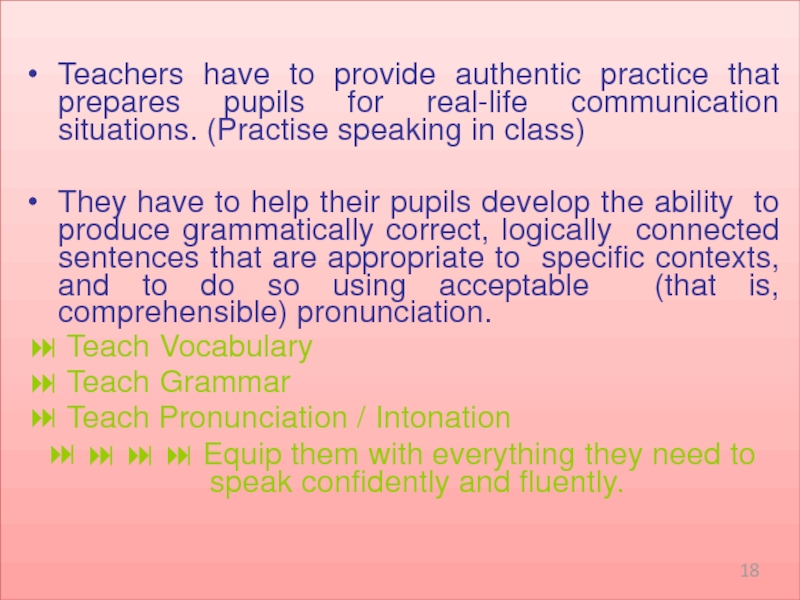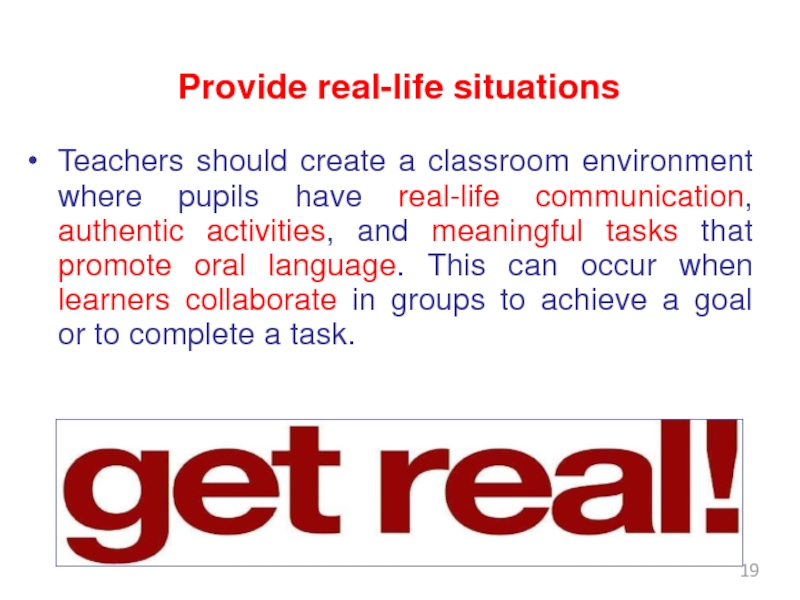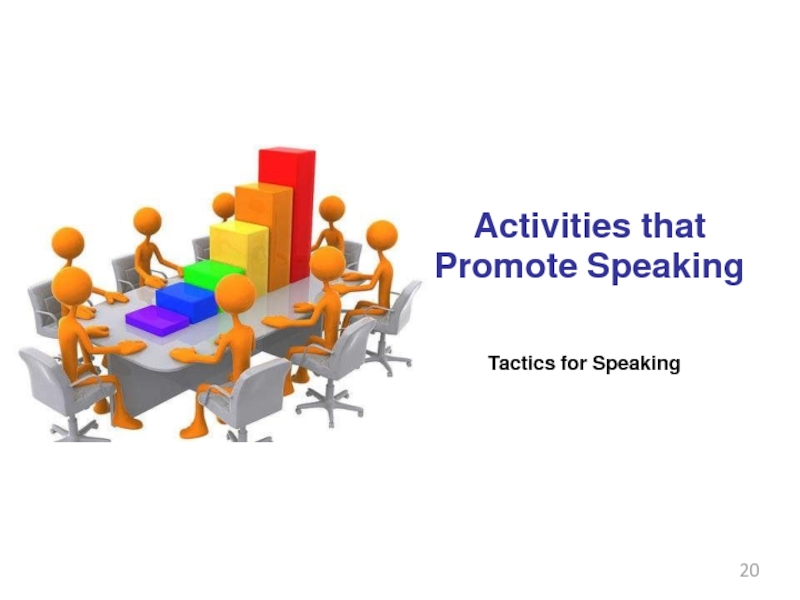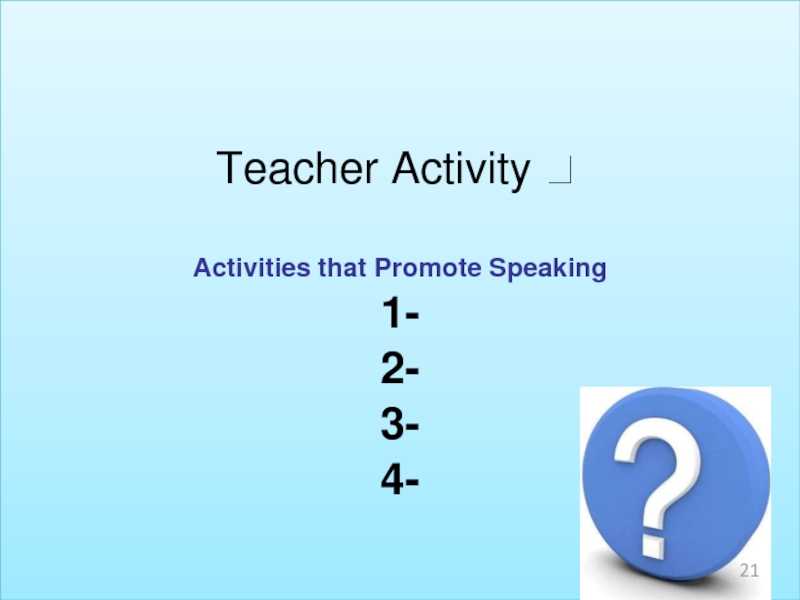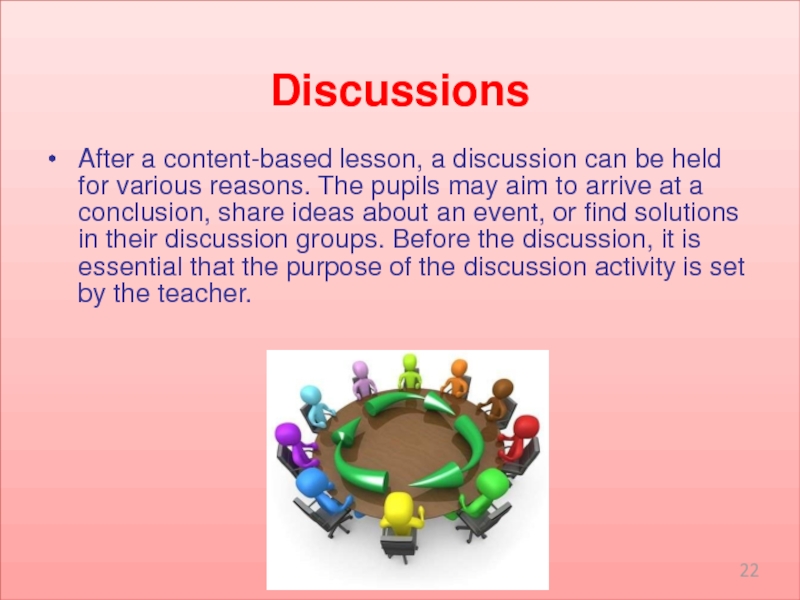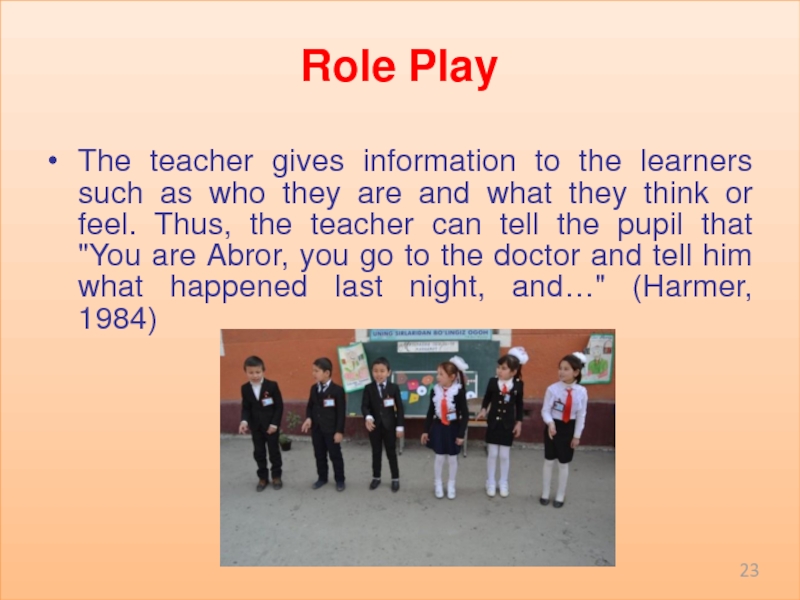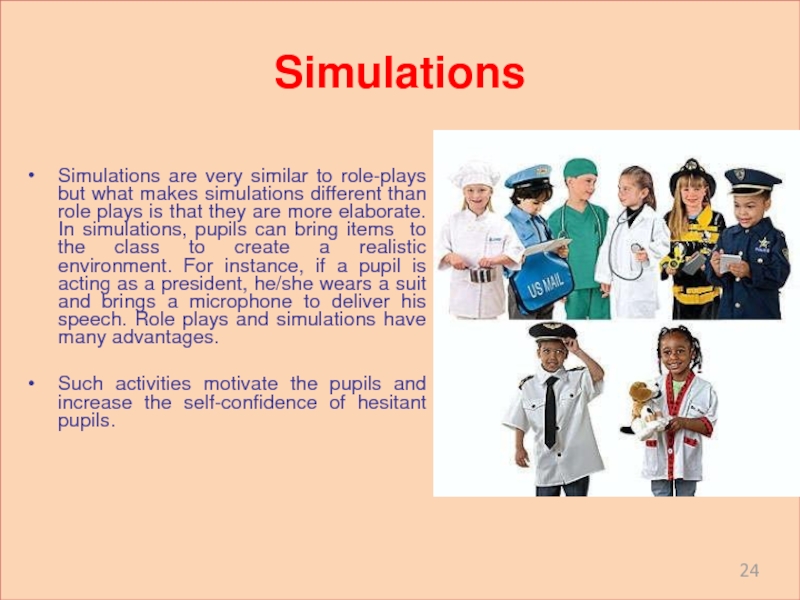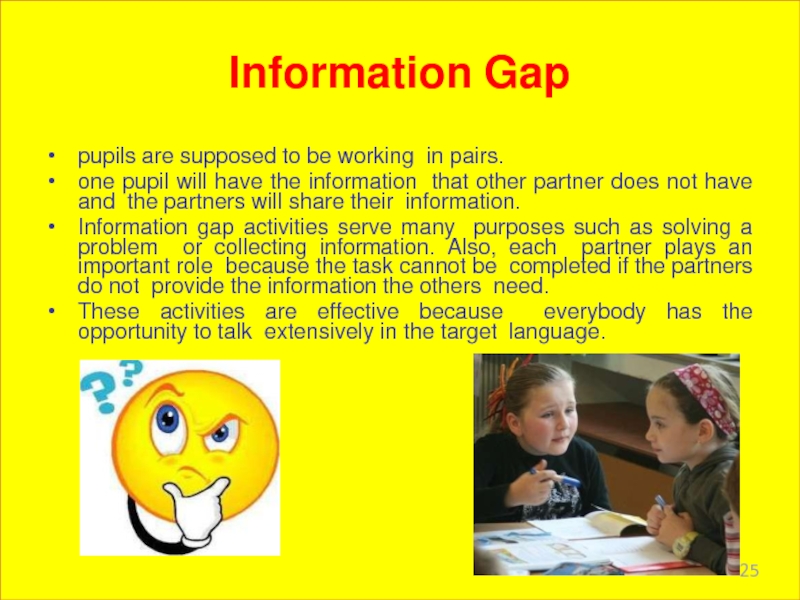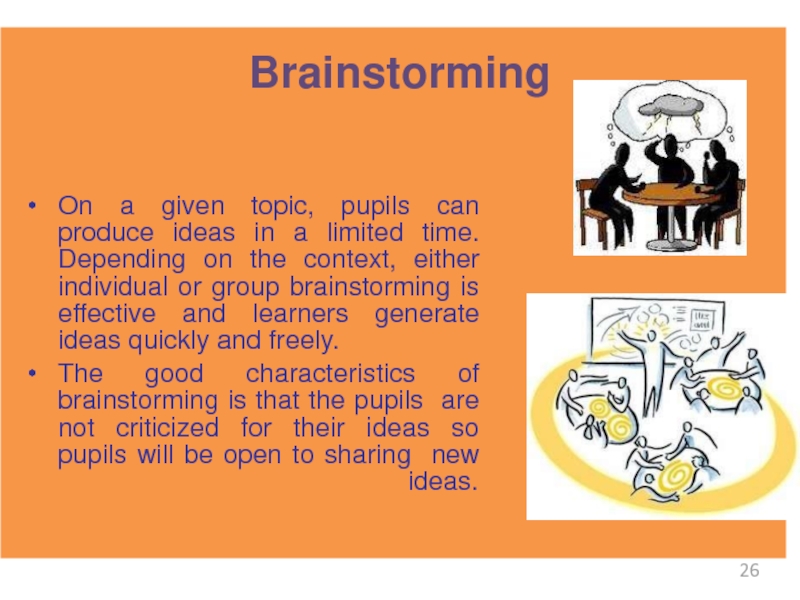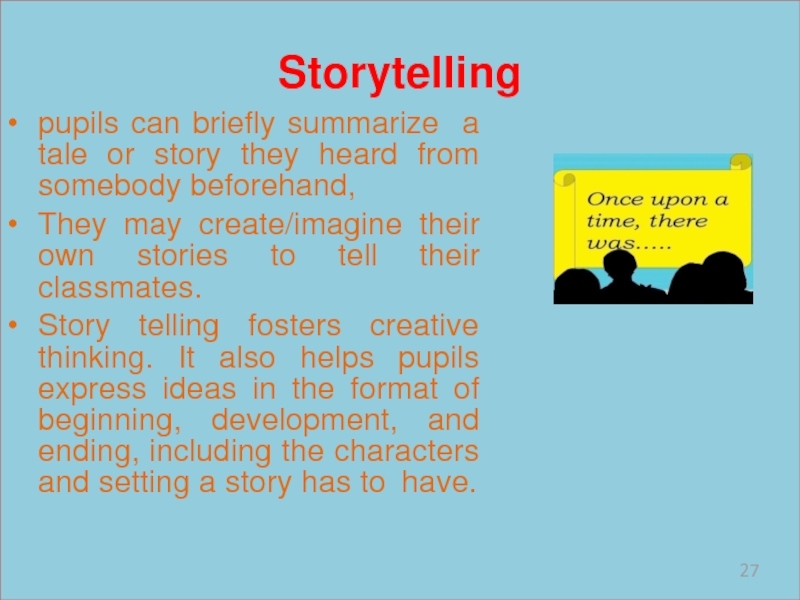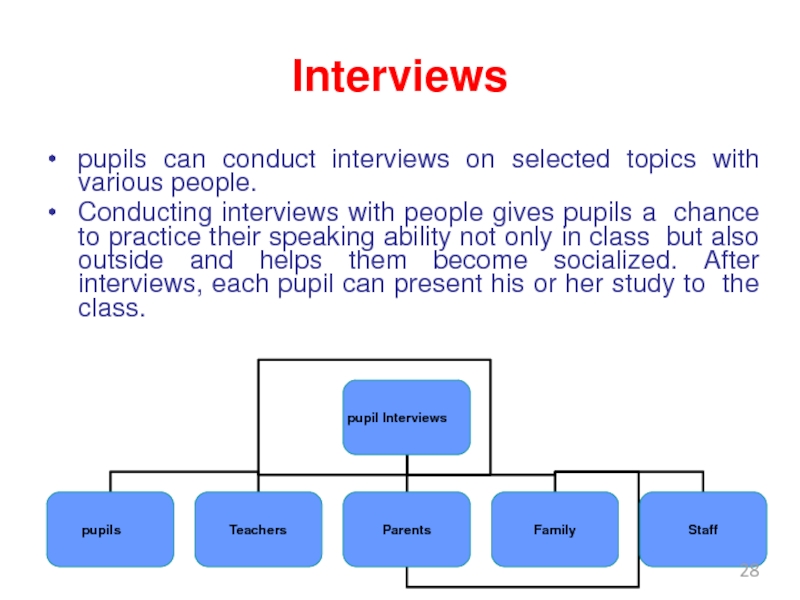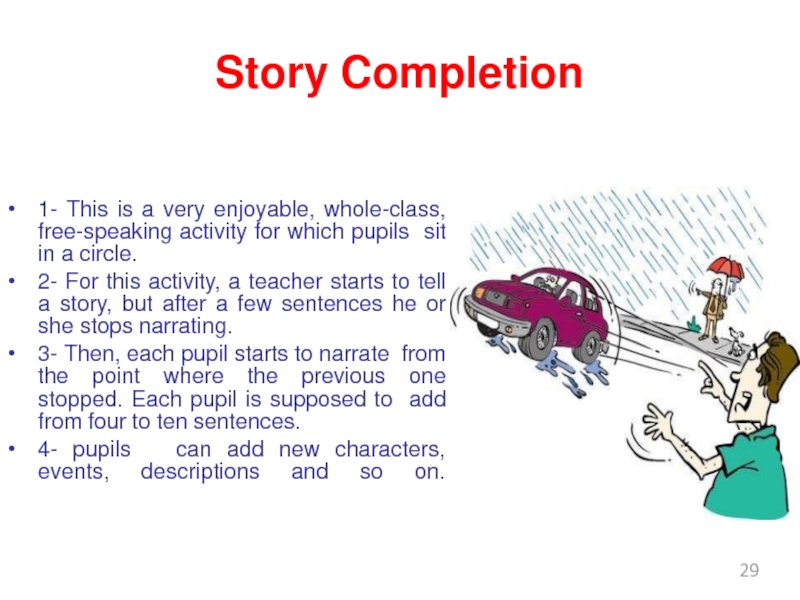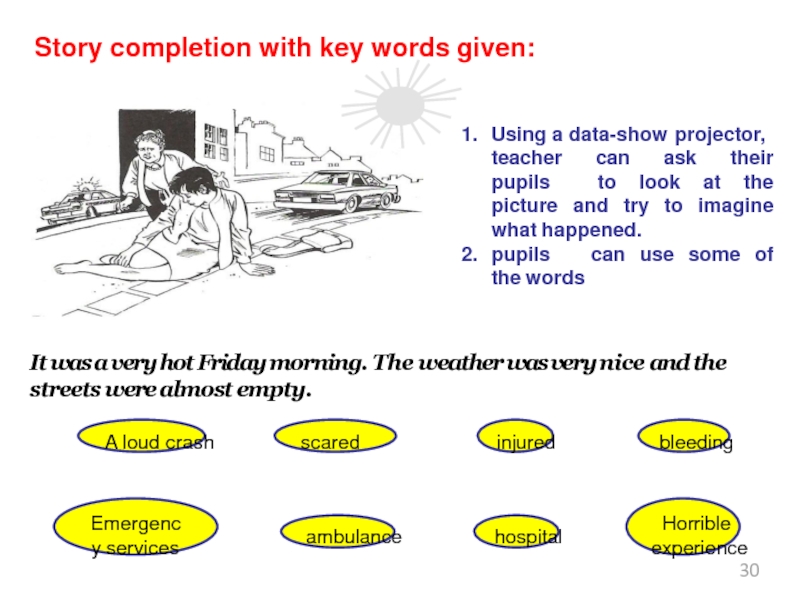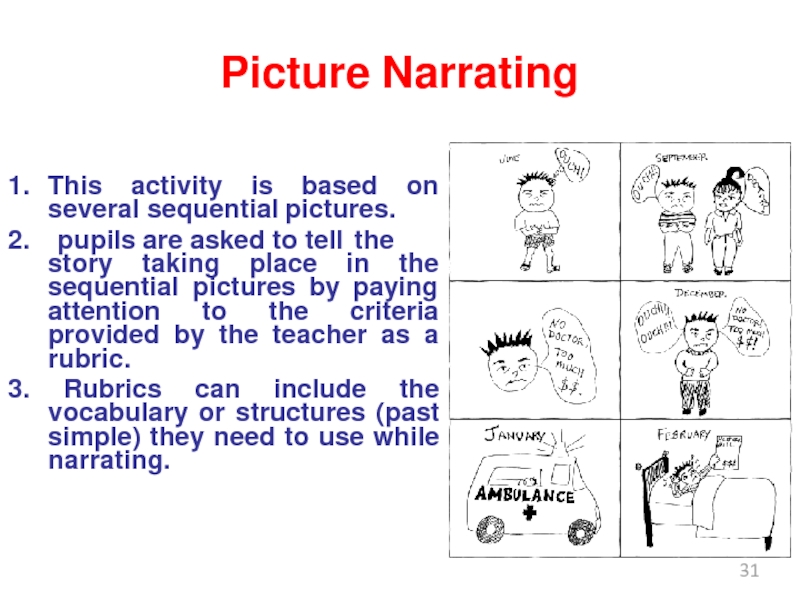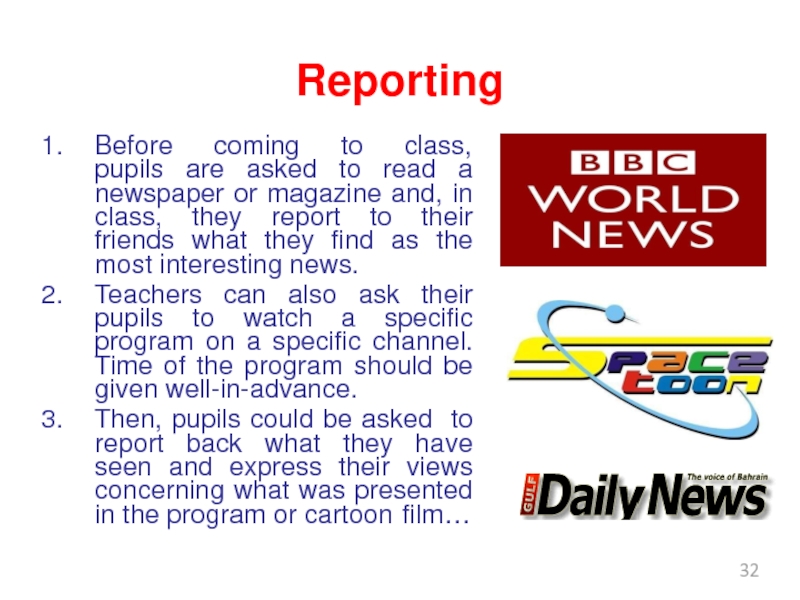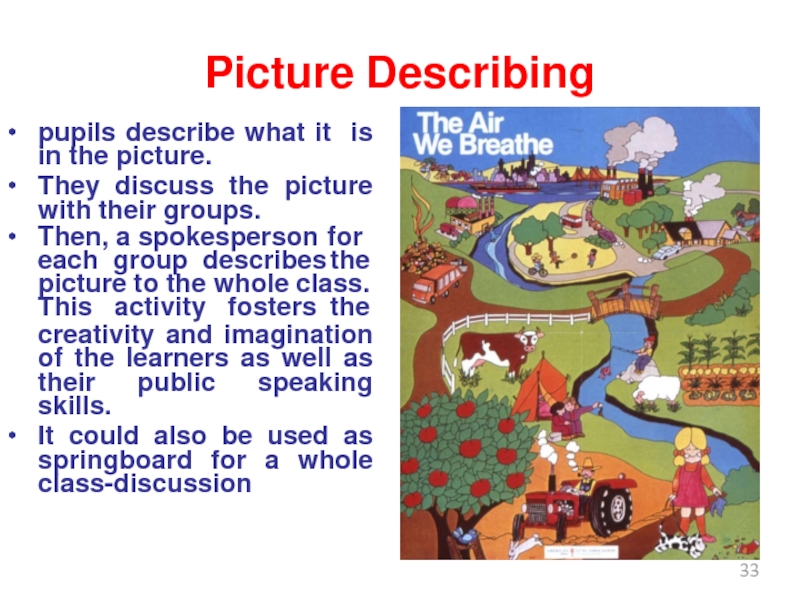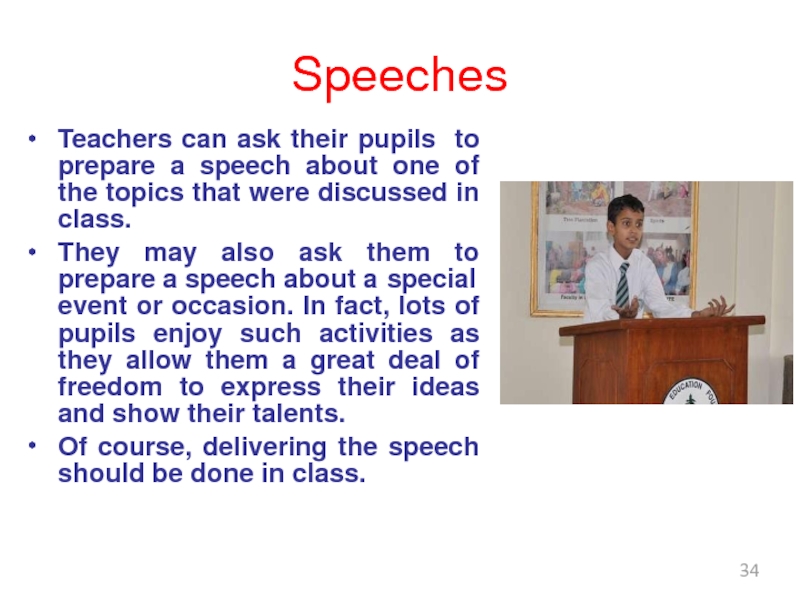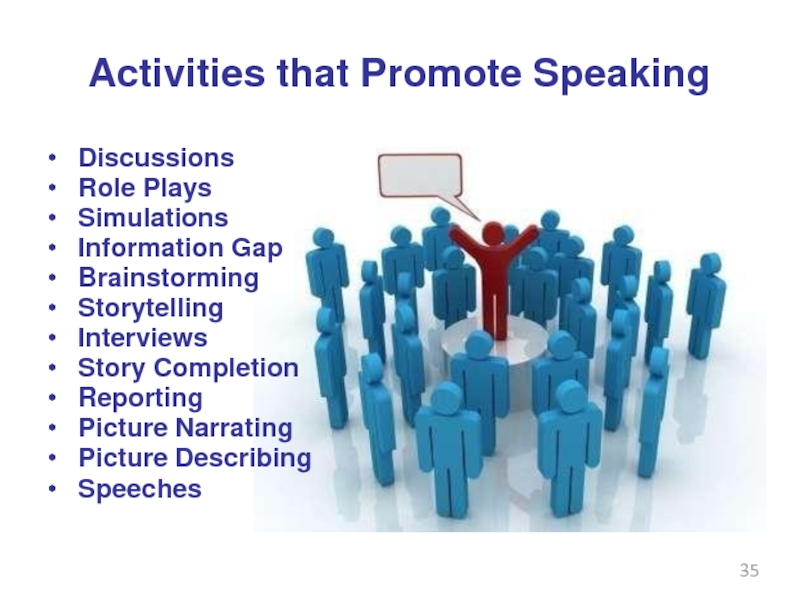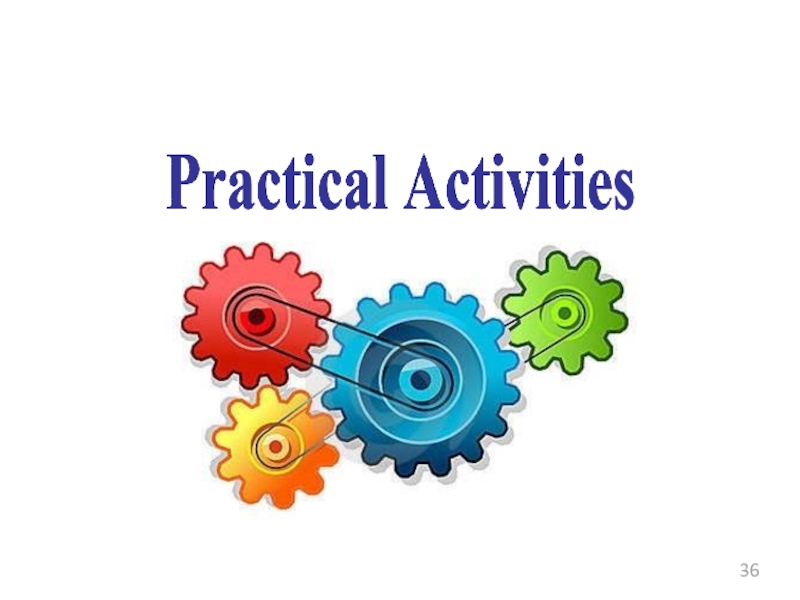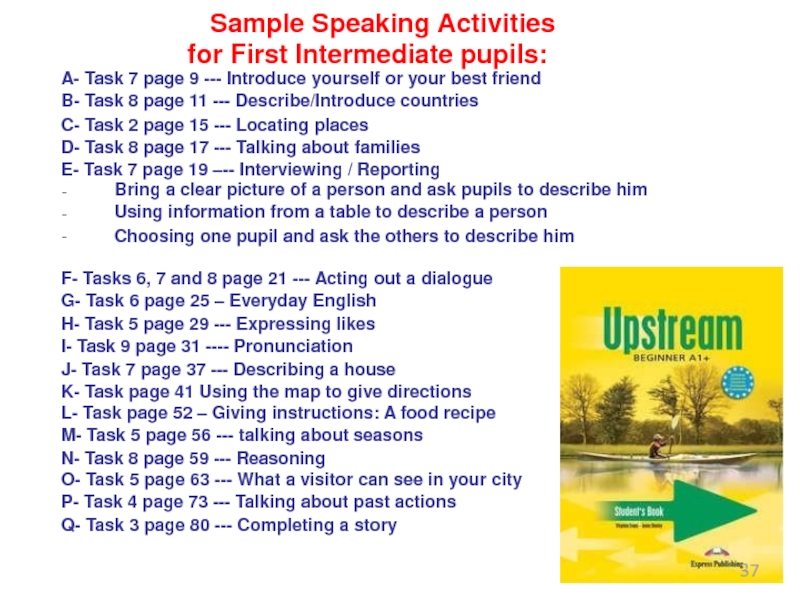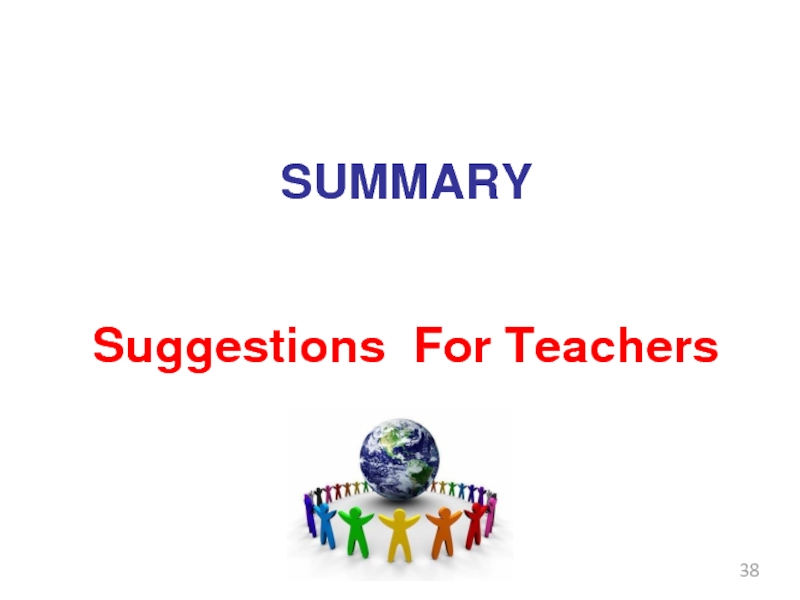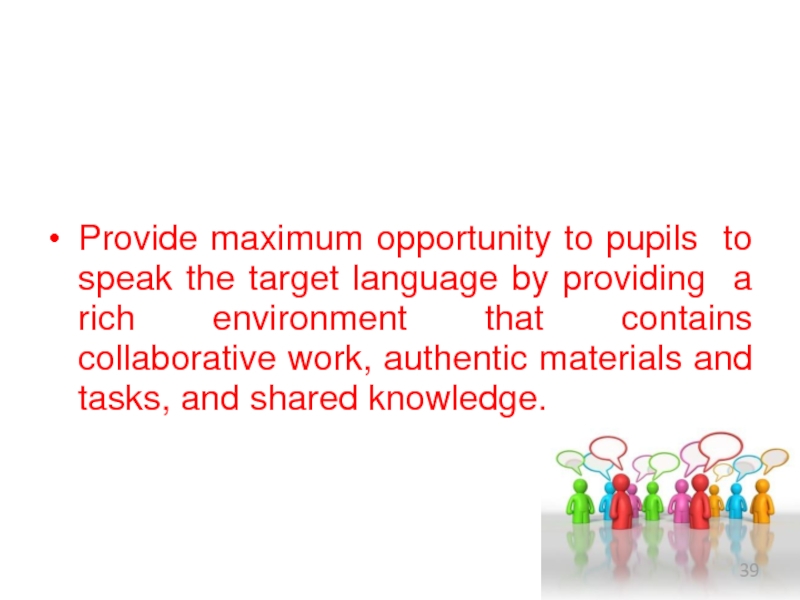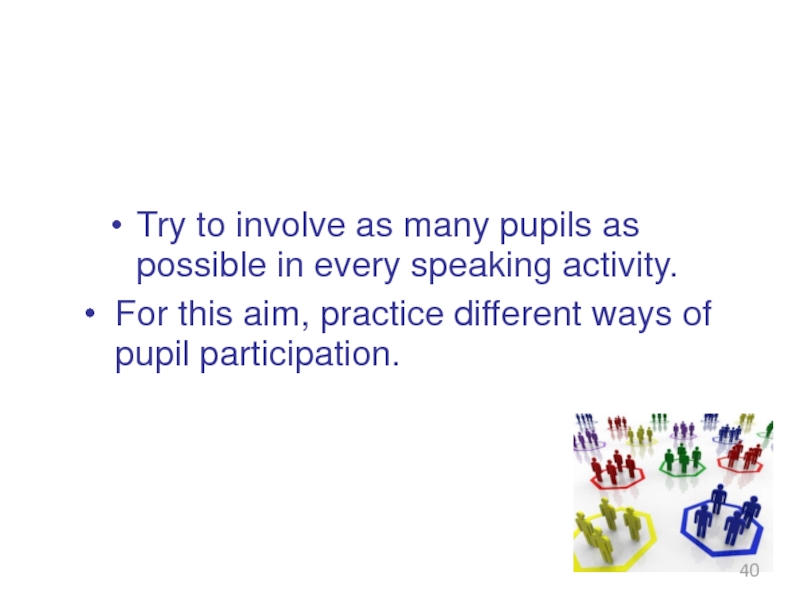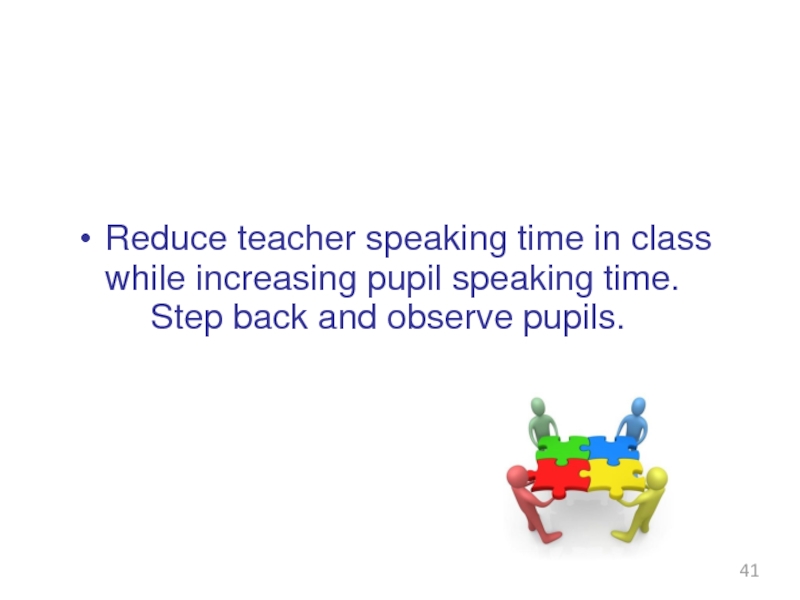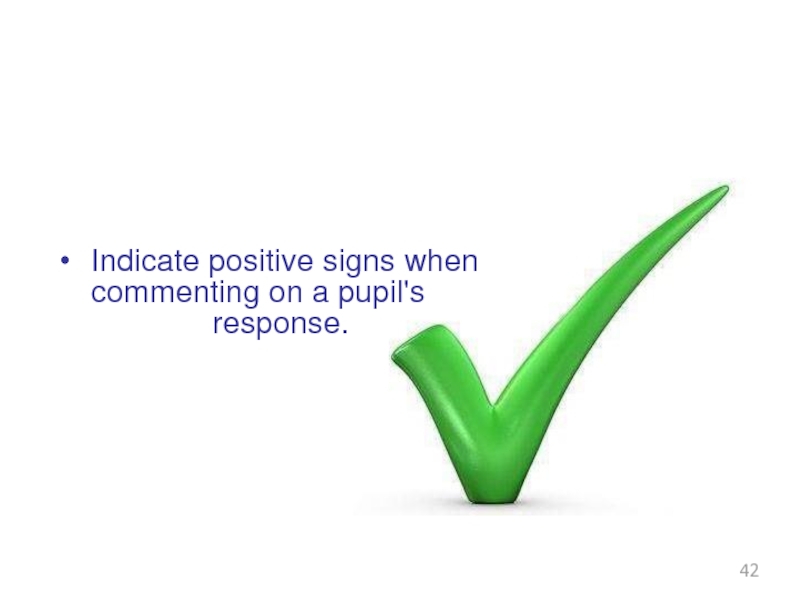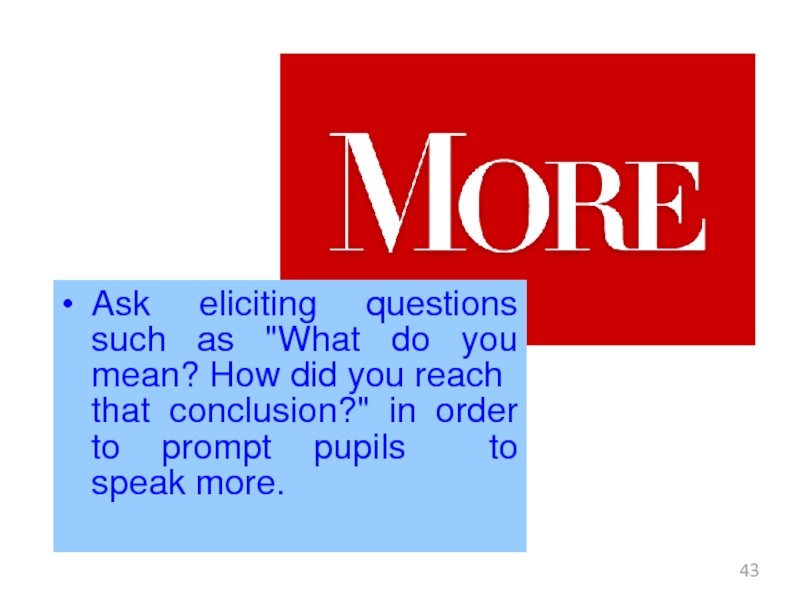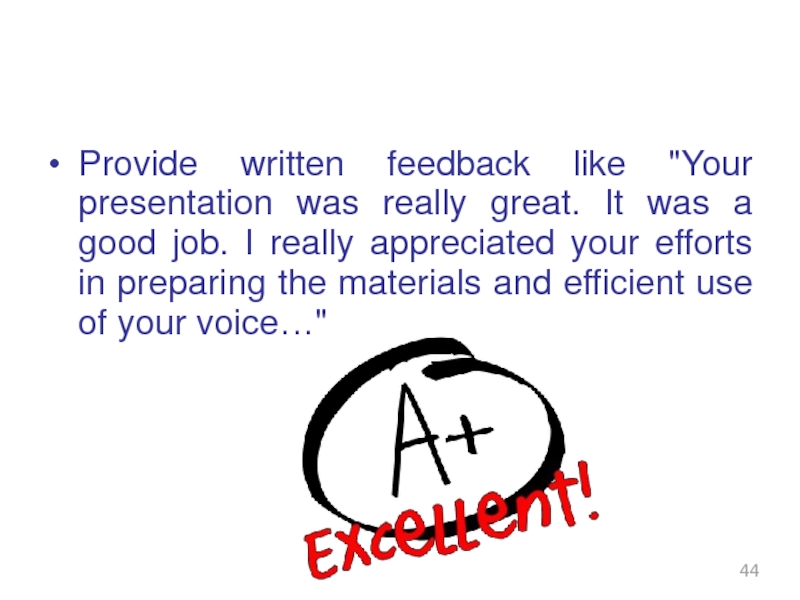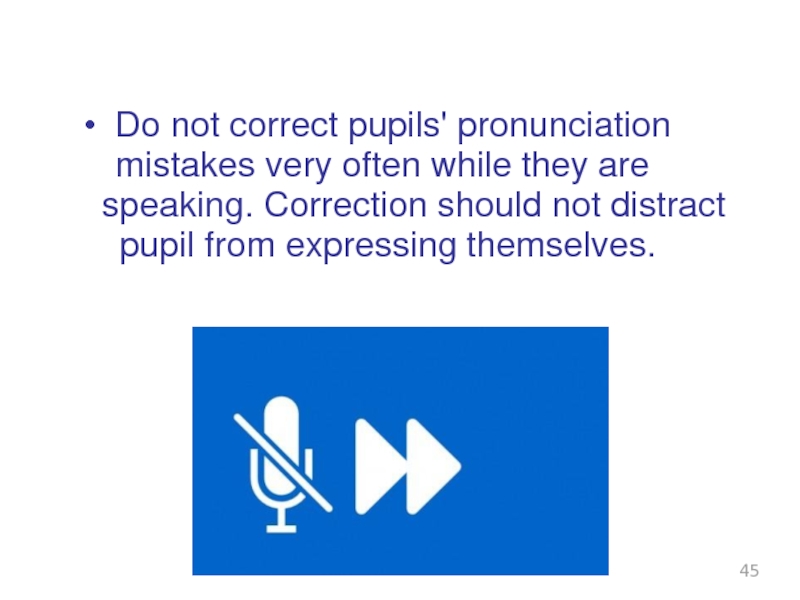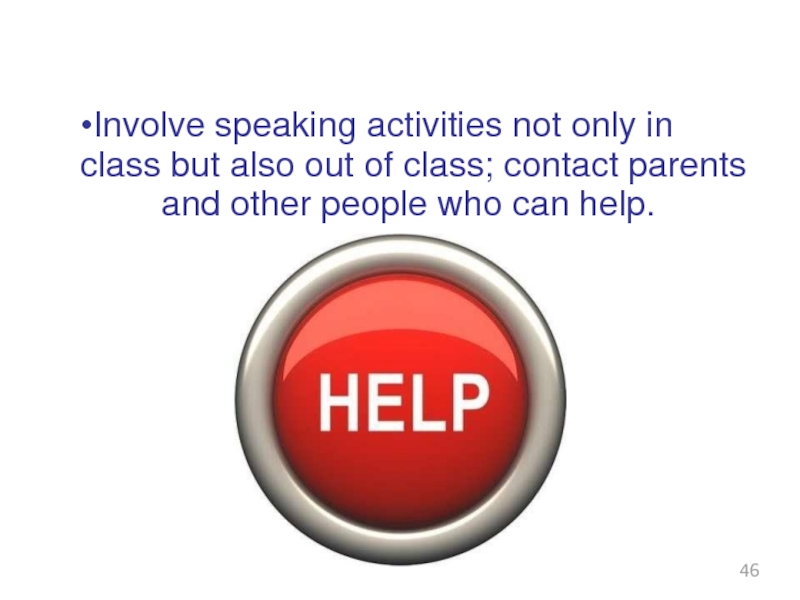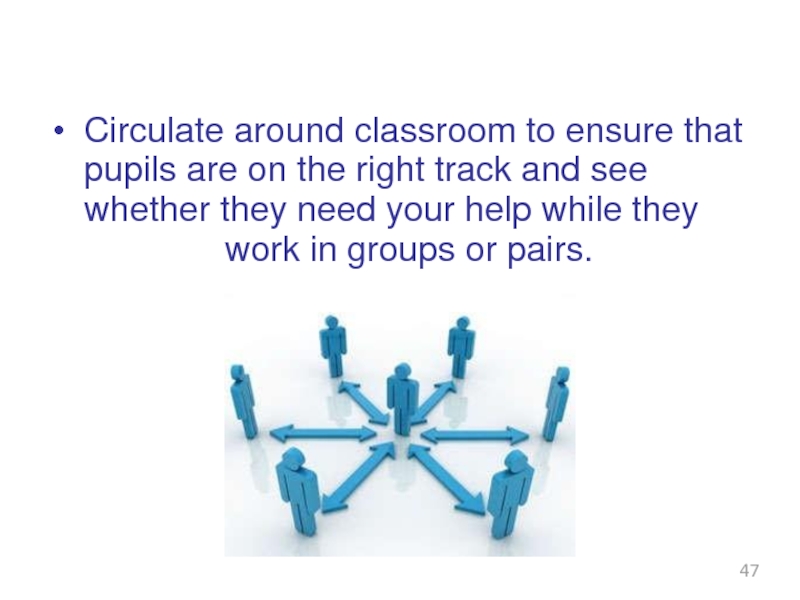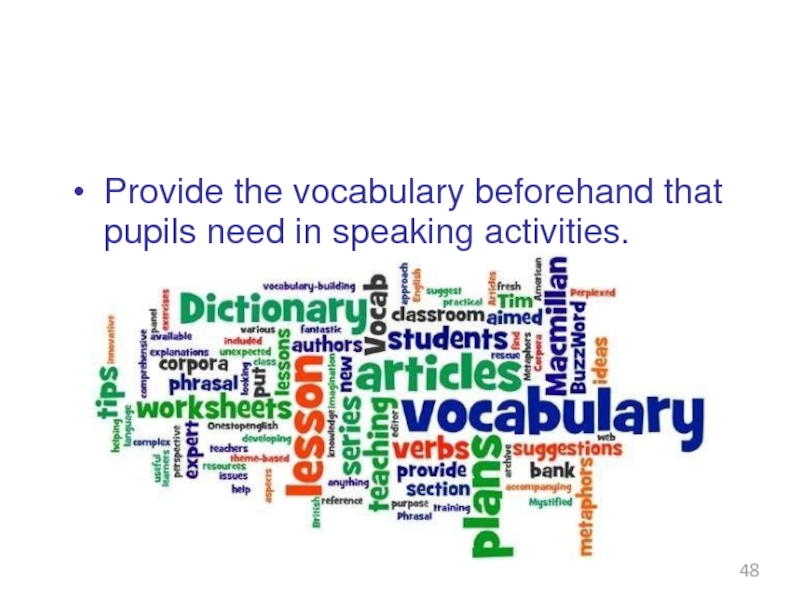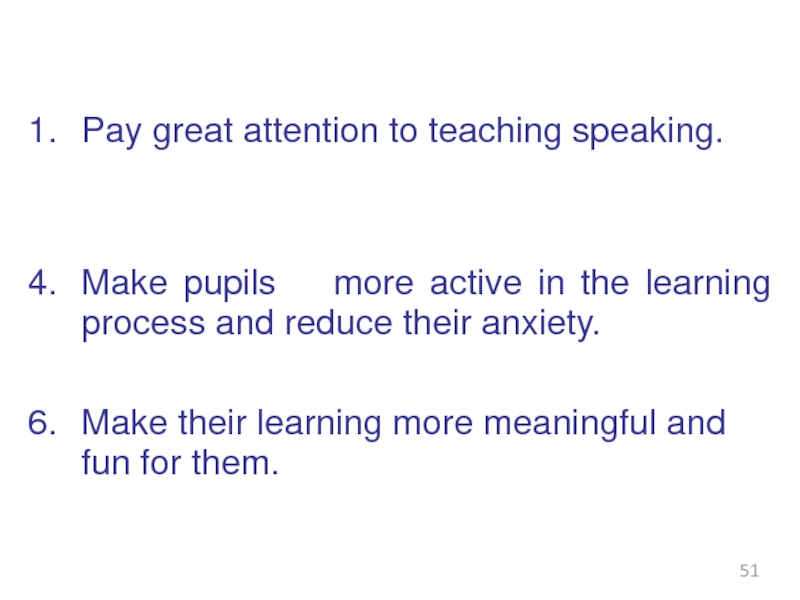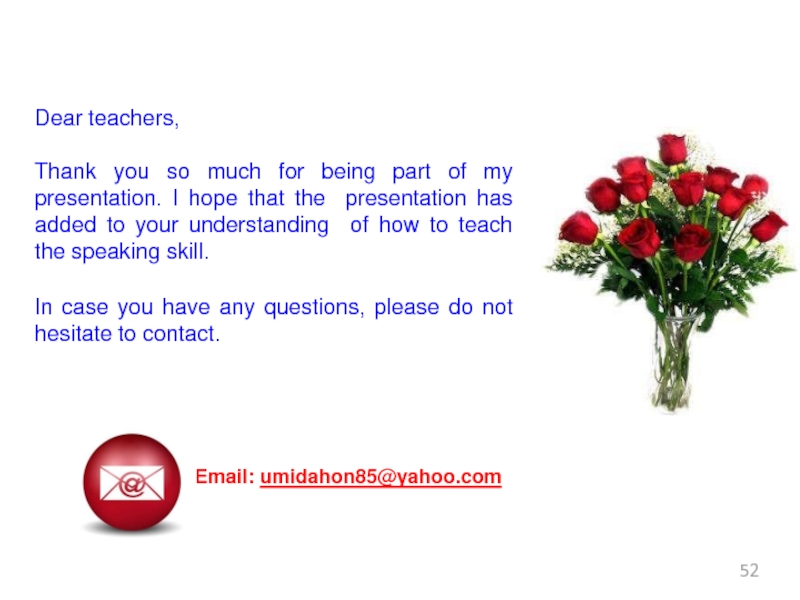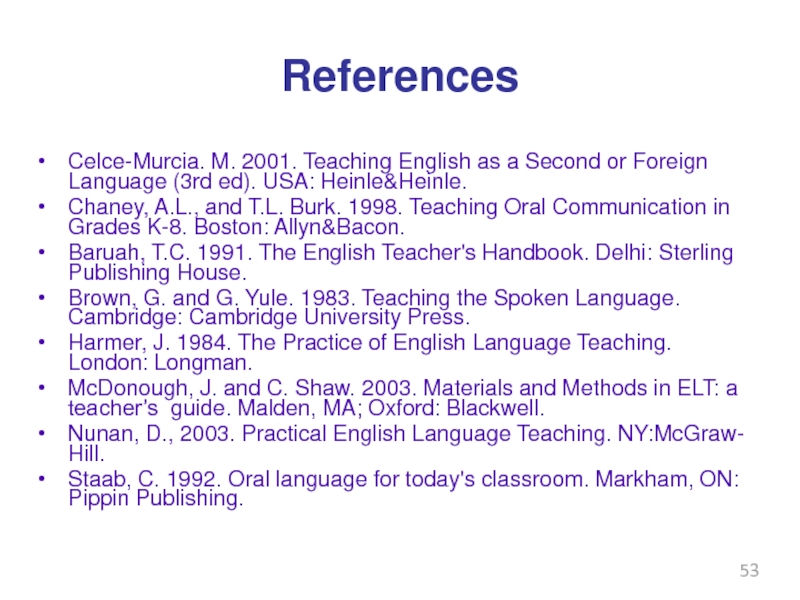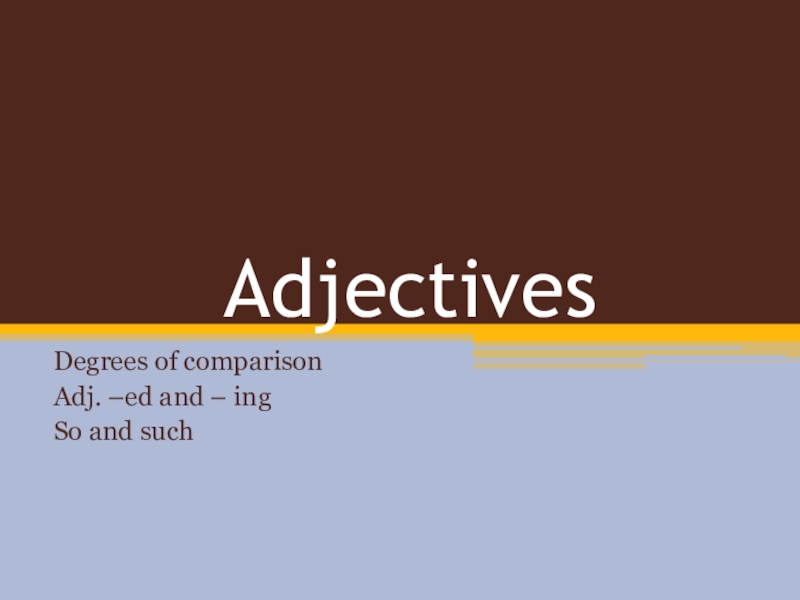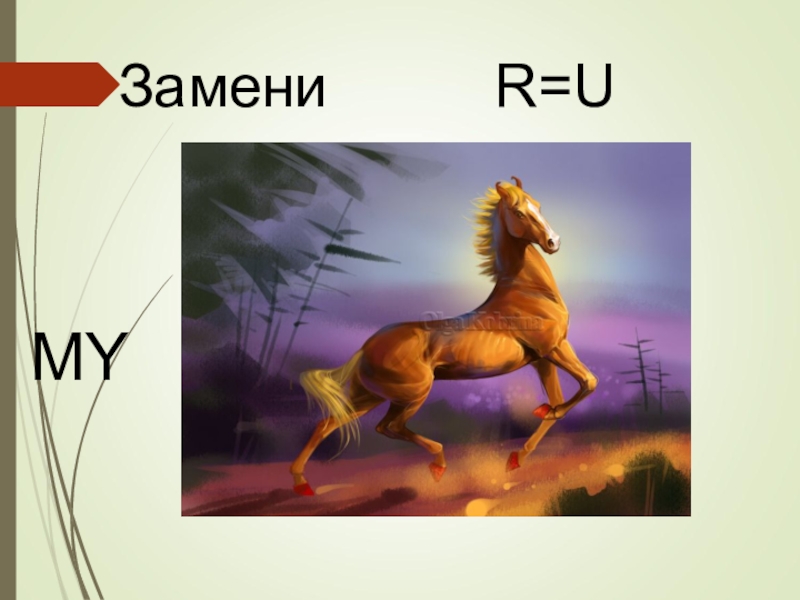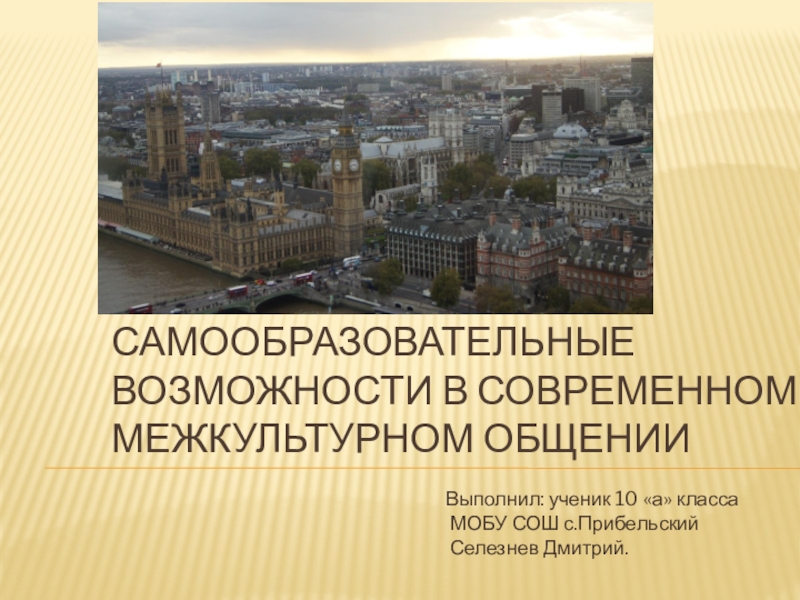- Главная
- Разное
- Образование
- Спорт
- Естествознание
- Природоведение
- Религиоведение
- Французский язык
- Черчение
- Английский язык
- Астрономия
- Алгебра
- Биология
- География
- Геометрия
- Детские презентации
- Информатика
- История
- Литература
- Математика
- Музыка
- МХК
- Немецкий язык
- ОБЖ
- Обществознание
- Окружающий мир
- Педагогика
- Русский язык
- Технология
- Физика
- Философия
- Химия
- Шаблоны, фоны, картинки для презентаций
- Экология
- Экономика
Презентация, доклад на тему Presentation Problems and solutions in teaching speaking English
Содержание
- 1. Presentation Problems and solutions in teaching speaking English
- 2. Do you think that pupils are good at speaking?
- 3. Слайд 3
- 4. Mother TongueTextbookBad HabitsTeachers’ MotivationClassroom Handicapspupils’ MotivationFactors
- 5. Main objectivesTo develop teachers’ ability to teach speakingTo develop pupils’ oral proficiency
- 6. Слайд 6
- 7. Speaking is "the process of building and
- 8. FeelingsOpinionsPersonal detailsFunctions:Giving adviceExpressing hopeTelling storiesDaily routinesDescribing: 1- PeoplePlacesObjectsHabitscontextsmeaningFormalInformalAt homeAt schoolIn the streetOn holidayAt a mallA situation
- 9. Do You know that ? ? ?Many
- 10. They regard speaking as the most important skill they can acquire, and they assess their progress in terms
- 11. First Part:Despite its importance, for many years,
- 12. No CommunicationNo InteractionNo NegotiationNo TransactionNo Information Exchange
- 13. What Makes a Good Speaker?
- 14. Teacher Activity Characteristics of a good language speaker1-2-3-4-5 mn
- 15. While speaking, we expect our pupils to
- 16. How do we teach speaking? A sample
- 17. Teacher Activity What do pupils need to talk fluently?1-2-3-4-5-5 mn
- 18. Teachers have to provide authentic practice that
- 19. Teachers should create a classroom environment where
- 20. Activities that Promote SpeakingTactics for Speaking
- 21. Teacher Activity Activities that Promote Speaking1-2-3-4-5 mn
- 22. DiscussionsAfter a content-based lesson, a discussion can
- 23. Role PlayThe teacher gives information to the
- 24. SimulationsSimulations are very similar to role-plays but
- 25. Information Gappupils are supposed to be working
- 26. BrainstormingOn a given topic, pupils can produce
- 27. Storytellingpupils can briefly summarize a tale or
- 28. Interviewspupils can conduct interviews on selected topics
- 29. Story Completion1- This is a very enjoyable,
- 30. Story completion with key words given:It was
- 31. Picture Narratingactivityis based onseveral sequential pictures.1. This2.pupils are asked to
- 32. Reporting1. Beforecoming to class,pupils are asked to read a newspaper
- 33. Picture Describingpupils describe what it is in
- 34. SpeechesTeachers can ask their pupils to prepare
- 35. Activities that Promote SpeakingDiscussionsRole PlaysSimulationsInformation GapBrainstormingStorytellingInterviewsStory CompletionReportingPicture NarratingPicture DescribingSpeeches
- 36. Слайд 36
- 37. Sample Speaking Activities for First Intermediate pupils:A-
- 38. SUMMARYSuggestions For Teachers
- 39. Provide maximum opportunity to pupils to speak
- 40. Try to involve as many pupils as
- 41. Reduce teacher speaking time in class while increasing pupil speaking time.Step back and observe pupils.
- 42. Indicate positive signs when commenting on a pupil'sresponse.
- 43. Askelicitingquestionssuchas "Whatdo youmean? How did you reach that conclusion?" in orderto promptpupils tospeak more.
- 44. Provide written feedback like "Your presentation was
- 45. Do not correct pupils' pronunciation mistakes very
- 46. Involve speaking activities not only in class
- 47. Circulate around classroom to ensure that pupils
- 48. Provide the vocabulary beforehand that pupils need in speaking activities.
- 49. Diagnose problems faced by pupils who have
- 50. Conclusion
- 51. 1. Pay great attention to teaching speaking.4. Make pupils more active in the learning process
- 52. Dear teachers,Thank you so much for being
- 53. ReferencesCelce-Murcia. M. 2001. Teaching English as a
Слайд 4Mother Tongue
Textbook
Bad Habits
Teachers’ Motivation
Classroom Handicaps
pupils’ Motivation
Factors
Слайд 5Main objectives
To develop teachers’ ability to teach speaking
To develop pupils’ oral proficiency
Слайд 7Speaking is "the process of building and sharing meaning through the
meaning
contexts
meaning
contexts
Слайд 8Feelings
Opinions
Personal details
Functions:
Giving advice
Expressing hope
Telling stories
Daily routines
Describing: 1- People
Places
Objects
Habits
contexts
meaning
Formal
Informal
At home
At school
In the
On holiday
At a mall
A situation
Слайд 9Do You know that ? ? ?
Many language learners regard speaking
Слайд 10 They regard speaking as the most important skill they can acquire, and they assess their progress in terms of their accomplishments in
Do You know that ? ? ?
Слайд 11First Part:
Despite its importance, for many years, teaching speaking has been
Second Part:
English language teachers have continued to teach speaking just as a repetition of drills or memorization of dialogues.
The main issues are:
Слайд 15While speaking, we expect our pupils to be able to:
Produce the
Use word and sentence stress, intonation patterns and the rhythm of the second language.
Select appropriate words and sentences according to the proper social setting, audience, situation and subject matter.
Organize their thoughts in a meaningful and logical sequence.
Use language as a means of expressing values and judgments.
Use the language quickly and confidently with few unnatural pauses, which is called as fluency. (Nunan, 2003)
The above mentioned criteria are also
the same criteria we use to test pipils’ ability to speak
Слайд 16How do we teach speaking?
A sample speaking activity
Tense: Present
Think about an activity
Meaning / Function
Context
Materials
5 mn
Слайд 18Teachers have to provide authentic practice that prepares pupils for real-life
They have to help their pupils develop the ability to produce grammatically correct, logically connected sentences that are appropriate to specific contexts, and to do so using acceptable (that is, comprehensible) pronunciation.
Teach Vocabulary
Teach Grammar
Teach Pronunciation / Intonation
Equip them with everything they need to speak confidently and fluently.
Слайд 19Teachers should create a classroom environment where pupils have real-life communication,
Provide real-life situations
Слайд 22Discussions
After a content-based lesson, a discussion can be held for various
Слайд 23Role Play
The teacher gives information to the learners such as who
Слайд 24Simulations
Simulations are very similar to role-plays but what makes simulations different
Such activities motivate the pupils and increase the self-confidence of hesitant pupils.
Слайд 25Information Gap
pupils are supposed to be working in pairs.
one pupil will
Information gap activities serve many purposes such as solving a problem or collecting information. Also, each partner plays an important role because the task cannot be completed if the partners do not provide the information the others need.
These activities are effective because everybody has the opportunity to talk extensively in the target language.
Слайд 26Brainstorming
On a given topic, pupils can produce ideas in a limited
The good characteristics of brainstorming is that the pupils are not criticized for their ideas so pupils will be open to sharing new ideas.
Слайд 27Storytelling
pupils can briefly summarize a tale or story they heard from
They may create/imagine their own stories to tell their classmates.
Story telling
fosters creative
thinking. It also helps pupils express ideas in the format of beginning, development, and ending, including the characters and setting a story has to have.
Слайд 28Interviews
pupils can conduct interviews on selected topics with various people.
Conducting interviews
pupil Interviews
pupils
Teachers
Parents
Family
Staff
Слайд 29Story Completion
1- This is a very enjoyable, whole-class, free-speaking activity for
2- For this activity, a teacher starts to tell a story, but after a few sentences he or she stops narrating.
3- Then, each pupil starts to narrate from the point where the previous one stopped. Each pupil is supposed to add from four to ten sentences.
4- pupils
can add new characters,
events, descriptions and so on.
Слайд 30Story completion with key words given:
It was a very hot Friday
A loud crash scared injured bleeding
Emergenc y services
ambulance
hospital
Horrible experience
1. Using a data-show projector,
teacher can pupils
to look
ask their at the
picture and
try to
imagine
what happened.
can use
some of
2. pupils the words
Слайд 31Picture Narrating
activity
is based on
several sequential pictures.
1. This
2.
pupils are asked to tell the
story
taking
place
in the
sequential pictures by paying
attention to the
criteria
provided by the teacher as a rubric.
3. Rubrics
Слайд 32Reporting
1. Before
coming to class,
pupils are asked to read a newspaper or magazine and, in
Teachers can also ask their pupils to watch a specific program on a specific channel. Time of the program should be given well-in-advance.
Then, pupils could be asked to report back what they have seen and express their views concerning what was presented in the program or cartoon film…
Слайд 33Picture Describing
pupils describe what it is in the picture.
They discuss the
Then, a spokesperson for
each group describes the
picture to the whole class.
This activity fosters the
creativity and imagination of the learners as well as their public speaking skills.
It could also be used as springboard for a whole class-discussion
Слайд 34Speeches
Teachers can ask their pupils to prepare a speech about one
They may also ask them to prepare a speech about a special
•
event or occasion. In fact, lots of pupils enjoy such activities as they allow them a great deal of freedom to express their ideas and show their talents.
Of course, delivering the speech should be done in class.
Слайд 35Activities that Promote Speaking
Discussions
Role Plays
Simulations
Information Gap
Brainstorming
Storytelling
Interviews
Story Completion
Reporting
Picture Narrating
Picture Describing
Speeches
Слайд 37Sample Speaking Activities for First Intermediate pupils:
A- Task 7 page 9
C- Task 2 page 15 --- Locating places
D- Task 8 page 17 --- Talking about families
E- Task 7 page 19 –-- Interviewing / Reporting
-
-
-
Bring a clear picture of a person and ask pupils to describe him Using information from a table to describe a person
Choosing one pupil and ask the others to describe him
F- Tasks 6, 7 and 8 page 21 --- Acting out a dialogue G- Task 6 page 25 – Everyday English
H- Task 5 page 29 --- Expressing likes I- Task 9 page 31 ---- Pronunciation
J- Task 7 page 37 --- Describing a house
K- Task page 41 Using the map to give directions
L- Task page 52 – Giving instructions: A food recipe M- Task 5 page 56 --- talking about seasons
N- Task 8 page 59 --- Reasoning
O- Task 5 page 63 --- What a visitor can see in your city P- Task 4 page 73 --- Talking about past actions
Q- Task 3 page 80 --- Completing a story
Слайд 39Provide maximum opportunity to pupils to speak the target language by
Слайд 40Try to involve as many pupils as possible in every speaking
For this aim, practice different ways of pupil participation.
Слайд 41Reduce teacher speaking time in class while increasing pupil speaking time.
Step
Слайд 43Ask
eliciting
questions
such
as "What
do you
mean? How did you reach that conclusion?" in order
to prompt
pupils to
speak more.
Слайд 44Provide written feedback like "Your presentation was really great. It was
Слайд 45Do not correct pupils' pronunciation mistakes very often while they are
speaking.
Слайд 46Involve speaking activities not only in class but also out of
and other people who can help.
Слайд 47Circulate around classroom to ensure that pupils are on the right
work in groups or pairs.
Слайд 49Diagnose problems faced by pupils who have difficulty in expressing themselves
Слайд 511. Pay great attention to teaching speaking.
4. Make pupils more active in the learning process and reduce their anxiety.
6. Make
Слайд 52Dear teachers,
Thank you so much for being part of my presentation.
In case you have any questions, please do not hesitate to contact.
Email: umidahon85@yahoo.com
Слайд 53References
Celce-Murcia. M. 2001. Teaching English as a Second or Foreign Language
Chaney, A.L., and T.L. Burk. 1998. Teaching Oral Communication in Grades K-8. Boston: Allyn&Bacon.
Baruah, T.C. 1991. The English Teacher's Handbook. Delhi: Sterling Publishing House.
Brown, G. and G. Yule. 1983. Teaching the Spoken Language. Cambridge: Cambridge University Press.
Harmer, J. 1984. The Practice of English Language Teaching. London: Longman.
McDonough, J. and C. Shaw. 2003. Materials and Methods in ELT: a teacher’s guide. Malden, MA; Oxford: Blackwell.
Nunan, D., 2003. Practical English Language Teaching. NY:McGraw- Hill.
Staab, C. 1992. Oral language for today's classroom. Markham, ON: Pippin Publishing.
